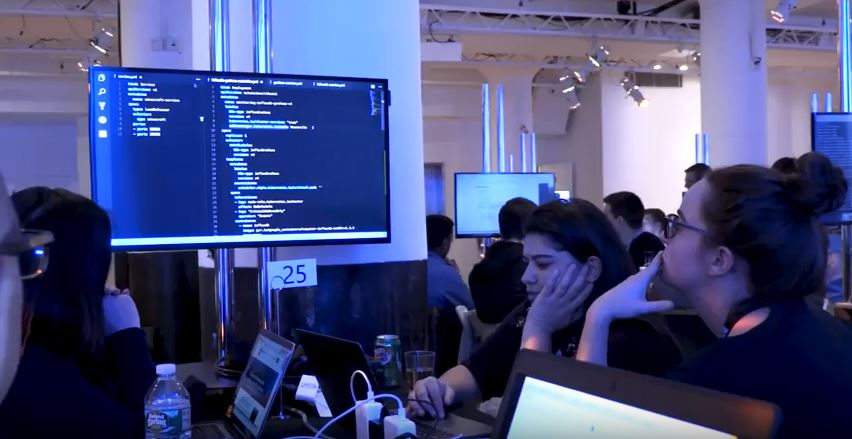Perspective dominates decision making, and when it comes to strengthening relationships, businesses should be working alongside their customers to gain a better perspective of their needs.
Understanding customers by working alongside them is something that the folks over at Microsoft are taking very seriously.
Last year the software giant from the Pacific Northwest hatched an idea to roll out a new methodology towards customer experience and relations called “open hacks.”

Still from Microsoft OpenHack NYC trailer
Open hacks — an initiative pioneered by the Microsoft Commercial Software Engineering (CSE) team — leverages direct evangelism, which puts customers at the heart of product development strategy.
“We send our own developers to work side by side with our customers to build technology that solves their biggest problems together. And in doing so, it has transformed the way we do business entirely,” Microsoft Technical Communications Director Dan Behrendt, wrote in a recent article on Entrepreneur.
Behrendt, who is also a member of The Sociable‘s Advisory Board, went on to explain that by working alongside its customers, Microsoft was able to see the problems through their perspectives, which led to better engagements and solutions.

Dan Behrendt
The open hacks strategy helps developers find hidden problems that are not obvious at first, but would be if the customer were involved in the process.
“With open hacks, we’ve come to understand the importance of open source procures, and have adapted to use the technology that our customers are most comfortable working with,” wrote Behrendt.
But the idea of open hacks through direct evangelism didn’t appear overnight. On the contrary, a lot of trial and error went into the process, and it wasn’t always a smooth ride for Microsoft.
The tech giant would hold DX Hackfests to try to solve customer problems internally, but without a side-by-side collaboration, Microsoft developers were falling into unknown pitfalls that their customers would have safely directed them away from had they been involved.
According to digital transformation expert, speaker, and author Paul Boag, working with customers on site “avoids misunderstanding, especially when multiple stakeholders are involved. Because you are on site you can speak to all of the stakeholders directly rather than always going through a single point of contact.”
If you are a bootstrapped startup, you may be thinking that working alongside your customers directly is out of the question due to limited resources.
However, the Microsoft director affirms that the idea of open hacks works for businesses of any size.
“Using the open hack method, startups and corporations — and companies of any size in between — have access to an effective alternative to spur a greater level of creativity and success. Startups, in particular, can use this method to band together, share their knowledge, improve their products and build their local startup ecosystems at the same time.”
It all comes back to perspective — seeing things in a new light and from other points of view.
“You see, all our ordinary views of things are no good, they do not lead anywhere. It is necessary to think differently, and this means to see things we do not see now, and not to see things we see now” – P.D. Ouspensky, The Fourth Way.
Companies that utilize the open hacks methodology will be able “to see things” they did not see before, like unknown, industry-specific problems that only the customer would know.
A developer may come up with a solution that looks good in theory, but if they have no working knowledge of the industry, it could end up wasting everybody’s time and efforts.
Just because programmers know how to develop an app, it doesn’t mean they know exactly what type of interface the customers need to better serve their users.
For example, someone who is developing a mobile app to survey youth homelessness will need to know a plethora of background on the issue before programming in order to know which types of questions to add.
Read More: Mobile developers are using code to help end youth homelessness
Likewise, companies that work alongside their customers will be able to “not see” the mistakes they would have made had they been working independently and internally.
With a side-by-side collaboration, problems that developers might have thought existed, won’t exist, because they would have face-to-face interactions in real time to clear everything up.
“By putting our own developers side by side with our customers’ developers and encouraging the use of open source solutions, we’ve been able to foster a dynamic environment for mutual innovation,” wrote Behrendt.
Apart from getting all the technical aspects right when it comes to side-by-side collaborations with customers, working alongside them also inspires trust and loyalty, which leads to longer retention.
According to Prescouter, “Customers are far more likely to stick with a company that values their opinion,” and, “repeat customers spend 33% more than new customers.”
Behrendt summed it up best when he wrote, “At the end of the day, a deep understanding of customers’ needs is the cornerstone of any successful business — regardless of its size. For startups, approaches like the lean startup methodology, design sprints and the infamous “pivot” were born out of the same idea: reacting to the needs of the customer. Open hacks is a new means to the same end.”












